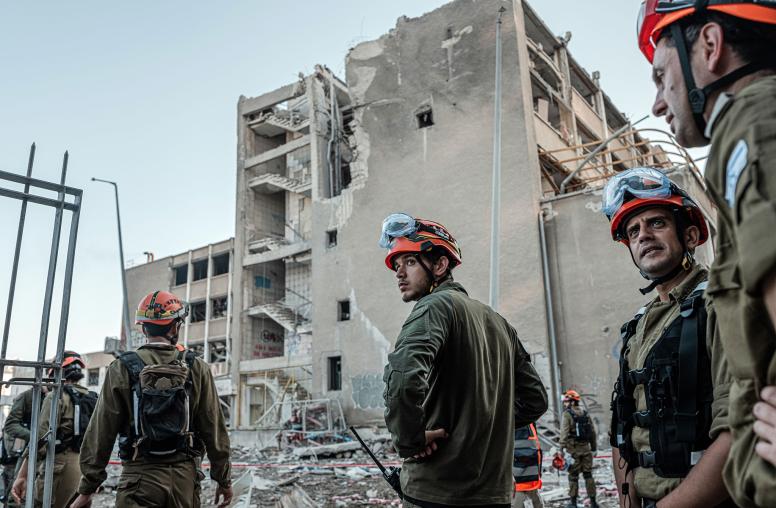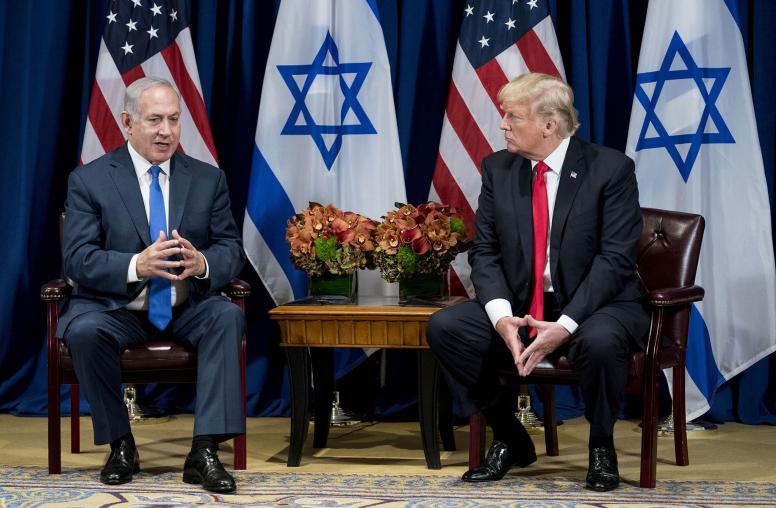As Hezbollah-Israel Tensions Simmer, Lebanon’s Domestic Crises Drag On
Ongoing hostilities in Lebanon and Syria could spark a full-blown war that would be catastrophic for Lebanon.
Editor’s Note: This Q&A was published before reports on April 1 that an Israeli airstrike destroyed an Iranian consulate in Damascus, Syria, reportedly killing at least five people including a senior Iranian Revolutionary Guard Corps commander.
Nearly six months after Hamas’s October 7 attack on Israel, tensions in two key flashpoints — Lebanon and Syria — continue to rise with significant Israeli airstrikes in both countries, leading to the highest death tolls in each country since October 7. Amid these rising tensions, ongoing clashes between the Lebanese militant group Hezbollah and the Israel Defense Forces (IDF) threaten to escalate into a wider war. At the same time, Lebanon continues to reel from a series of crises that have unfolded over the past four and a half years, highlighting Lebanon’s perilous position as the Gaza conflict continues to reverberate throughout the region.

USIP’s Mona Yacoubian provides an update on this volatile flashpoint as well as the domestic situation in Lebanon and discusses the prospects for de-escalation.
How significant are the hostilities between Hezbollah and Israel? What is the calculus of each side regarding an escalation to full-fledged conflict?
Cross-border hostilities between Hezbollah and Israel continue to escalate, yet the violence has not exploded into an all-out war. Since October, the Israel-Lebanon border has been a major flashpoint, with cross-border fire occurring nearly daily. Hassan Nasrallah, the leader of the Iran-backed Hezbollah, initiated attacks on Israel in support of Hamas, its primary Palestinian ally in the “axis of resistance,” and has promised to continue cross-border strikes until Israel ends “its aggression” on Gaza.
Last week witnessed the most intense days of hostilities in Lebanon and Syria since the beginning of the Gaza conflict. Israel’s March 29 strikes on targets in Syria’s Aleppo governorate reportedly killed 33 Syrians and six Hezbollah fighters, the most significant Israeli strike on Syria in years. Meanwhile, March 27 marked the deadliest day in Lebanon since the outbreak of hostilities, with 16 people killed. Israel carried out a several strikes against what it termed a “significant terrorist operative” in southern Lebanon. However, Lebanon’s health ministry said the first strike hit a medical facility and killed seven medics. Subsequent Israeli strikes reportedly killed nine other people.
Hezbollah retaliated with attacks on consecutive days, launching 30 rockets into northern Israel, killing a 25-year-old civilian in Kiryat Shimona. The following day, March 28, Hezbollah responded to the Israeli strikes using heavier bombs for the first time and also claiming to target civilians; Israel reported no casualties from the Hezbollah attack. Tensions further escalated on March 30 when three U.N. observers and a translator were wounded in a blast in southern Lebanon. The origin of the strike remains under investigation.
The violence has exacted a significant toll in both Israel and Lebanon, displacing tens of thousands on both sides of the border as well as resulting in civilian casualties. In Israel, 11 civilians have been killed in the north to date, while in Lebanon the civilian death toll from the fighting is estimated at 50. Although most of the attacks have remained in border regions, Israel has at times launched strikes deeper into Lebanon, including in the Bekaa Valley — 60 miles from the Israeli border and outside the town of Sidon. Over the course of the fighting, the Israeli military reports striking more than 4,500 Hezbollah targets in both Lebanon and Syria. Hezbollah reports it has lost close to 250 of its fighters and 14 Israeli soldiers have been killed in the north, according to Israeli military sources.
Despite the persistence of cross-border fighting, neither Israel nor Hezbollah appears to seek an all-out confrontation. For its part, Hezbollah has sought to tread a delicate path, responding to its “resistance” imperative with strikes largely limited to the Israeli border region, without provoking a significantly bigger response from Israel. Given Lebanon’s dire domestic circumstances and strong public opposition to what would be a devastating war with Israel, Hezbollah appears to be calibrating its military engagement with this calculus in mind.
Meanwhile, with the IDF focused on the war in Gaza and likely planning an incursion into Rafah in southern Gaza, Israel appears to have little appetite for opening a second front in the war at this time, though in the wake of October 7, is keenly concerned about restoring deterrence, an imperative with strong implications for its ongoing tolerance for Hezbollah’s Radwan Force so close to its northern border. Israeli forces are already stretched and contending with numerous challenges, including potentially an incipient insurgency in Gaza. However, while neither side currently appears to seek a wider war, the chances of miscalculation and unintended escalation are high. The history of conflict between Israel and Lebanon is riddled with erroneous decisions and misunderstandings leading to wider war.
What are the prospects for de-escalation? What role is the United States playing?
As long as the conflict rages in Gaza, prospects for de-escalation on the Israel-Lebanon border remain dim. However, U.S. diplomatic efforts to prevent a full-scale war continue. Special Presidential Envoy Amos Hochstein has engaged in periodic shuttle diplomacy with trips to Israel and Lebanon. Since the outbreak of hostilities between Hezbollah and Israel in October, the White House envoy has traveled to the countries three times in an effort to de-escalate tensions. Hochstein successfully negotiated a permanent maritime border between Israel and Lebanon in October 2022 and is a trusted interlocutor in both Israel and Lebanon.
At a minimum, Hochstein may seek a deal in which Hezbollah operatives move some miles off the border with Israel. Under this formulation, the Lebanese Armed Forces would deploy into these areas, deepening its presence in southern Lebanon. Such a deal would reduce hostilities in the region and allow the estimated 60,000 displaced Israelis and 90,000 displaced Lebanese to return to their homes. Over time, a more ambitious goal is to demarcate the land border between Israel and Lebanon as a follow-on to the maritime deal. Discussions have also explored the need to fully implement U.N. Security Council Resolution 1701, which was passed in August 2006 as part of the cessation of hostilities following the July 2006 Israel-Lebanon war.
Lebanon has contended with a multi-level crisis for over four years. What has been the impact of escalating tensions between Hezbollah and Israel on Lebanon’s domestic situation?
Lebanon remains embroiled in a series of cascading crises that have befallen the country since 2019 when its economy spiraled into near total collapse. Since then, Lebanon has endured multiple crises including the COVID-19 pandemic, the August 2020 Beirut port blast and Ukraine conflict-related food shortages and price hikes in 2022, all leading to a multi-layered socioeconomic meltdown that has resulted in record poverty rates, food insecurity, brain drain and the collapse of public services. Lebanon has also been in the throes of a presidential vacuum since November 2022. The parliament has repeatedly failed to elect a president, leaving the country somewhat adrift and in the hands of a caretaker government. This political legitimacy gap further constrains the Lebanese government’s ability to respond effectively to the country’s panoply of internal and external challenges.
It is against this precarious backdrop that Lebanon has been contending with the dangerous spillover from the Gaza conflict. The World Bank projects that the impact from the war in Gaza will throw Lebanon back into recession, including a drop in tourism, which had been an important driver of the country’s weak, but desperately needed, recovery. The conflict’s impacts on south Lebanon are also notable as the area is important to Lebanon’s economy, comprising nearly a quarter of the agricultural sector.
In Lebanon’s dire state, the impacts of a full-blown war with Israel would be catastrophic. The country’s collapsed health sector — reeling from a dearth of medical professionals, medicine shortages and underfunded health facilities — underscores just how ill prepared Lebanon is to manage through a major war. Moreover, the current levels of internal displacement would undoubtedly expand significantly. Yet, unlike in 2006 when many Lebanese fled to Syria, that escape route would be cut off given Syria’s ongoing conflict. As the Lebanese struggle through this latest crisis, the potential ramifications of a resumption of major war with Israel are unimaginable.



